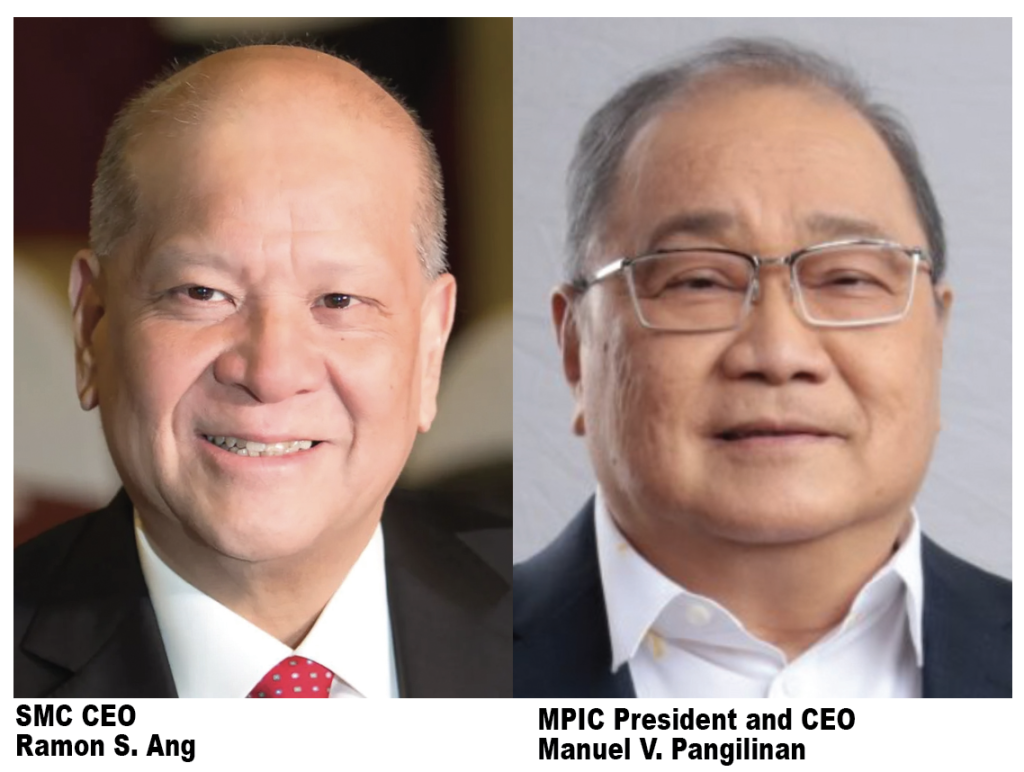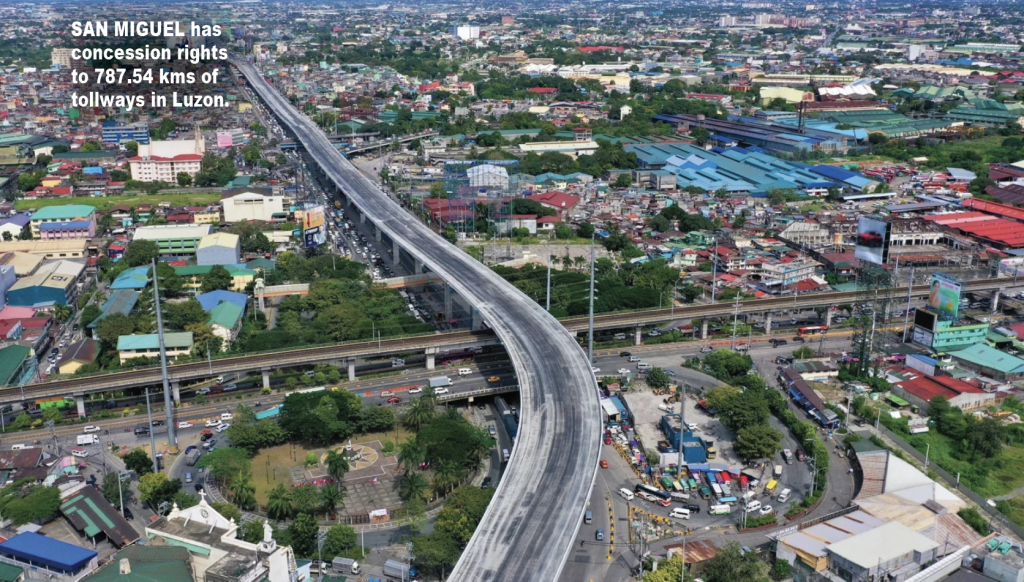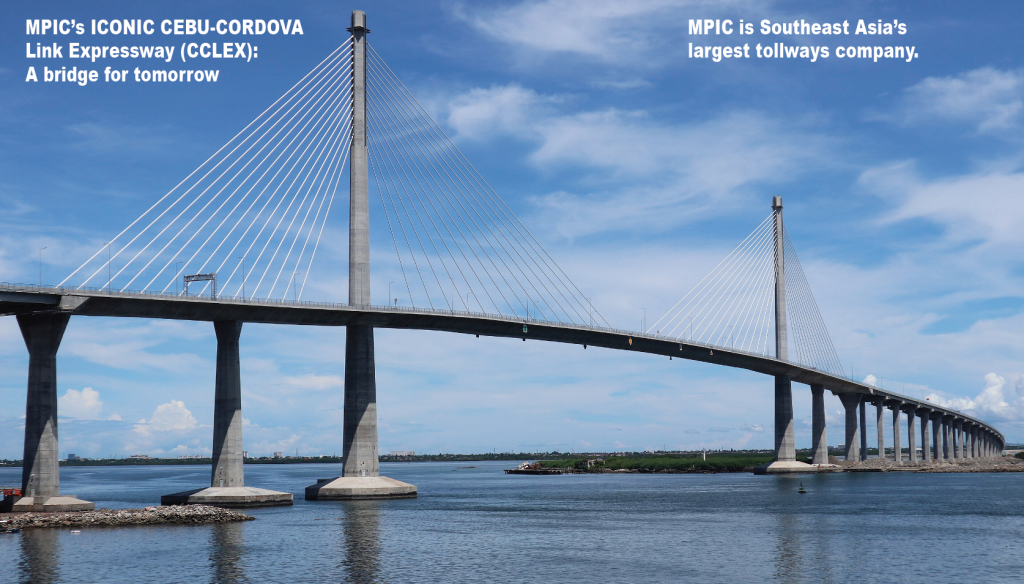By Tony Lopez

San Miguel Corp. President and CEO Ramon S. Ang and Metro Pacific Investments Corp. Chair, President and CEO and Manuel V. Pangilinan are talking to merge their respective tollways operations—SMC Tollways (under San Miguel Infrastructure Holdings) and Metro Pacific Tollways Corp. (MPTC), under MPIC.
Merging the two tollways giants could result in an infrastructure behemoth with an enterprise value of up to P900 billion ($16.36 billion at P55 to $1). Together, SMC and MPIC form the Philippines’ biggest infrastructure company.
The two conglomerates are cashing in on the government’s major growth strategy, which is to build P9 trillion worth of infrastructure projects to modernize the economy, attract more foreign investments, and achieve an upper middle income for the Filipino before or by 2028 when President Ferdinand R. Marcos Jr. ends his term.

More expressways planned
Combined, SMC and MPIC plan major highways, including an expressway to scenic Tagaytay, an expressway on top of major highway EDSA, and an expressway on top of Katipunan Road in Quezon City’s university district. Major urban areas like Cebu, Iloilo and Davao will likely get projects too.
The numerous foreign partners of both SMC (which has over 100 plants in the region) and MPIC, a subsidiary of First Pacific of Hong Kong, are likely to be enticed to help invest in infra in the Philippines.
MPIC has 262 kms of tollways portfolio in the Philippines, plus 207 kms in Vietnam and Indonesia.
San Miguel says it has concession rights to 787.54 kms of tollways in Luzon, enough to connect windy Pagudpud in the north to spicy Bicol in south Luzon in six hours.
Enterprise value measures a company’s capitalization, debt, and cash and near-cash holdings.
To value an enterprise, analysts often calculate its earnings over a period of years and discount the amount by an imputed cost of money, usually the prevailing interest rate and required rate of return. In infra, that return could be 12%-14% per year—above the February 2024 inflation rate of 3.4% and above current corporate borrowing rate of 5% to 9%.

Tollways hugely profitable
Tollways business is immensely profitable. Since motorists pay in advance or in cash, receivables are zero.
In 2022, MPTC reported EBITDA of P16.28 billion over revenues of P22.85 billion, an EBITDA margin of 39%. EBITDA is earnings before interest, income tax, and depreciation. Roads are depreciated in 20 years or at 5% per year.
In 2023, SMC Tollways had an EBITDA of P27 billion on revenues of P34 billion, for an EBITDA margin of 79.4%, whopping by any standard.
The SMC-MPIC tollways business will have a starting EBITDA of P50 billion, according to MVP. “Both companies are doing well,” he says. The merger, he reckons, “can be done this year. This business is not complex.”
IPO planned
The new tollways conglomerate could then sell its shares to the public thru an IPO (initial public offering). At 9x P50-billion EBITDA, the enterprise can have a market capitalization of P450 billion in a bull market, making it the second largest corporation in the Philippines after the P1.2 trillion market cap of SM Investments Corp..
The SMC-MPTC merger could be bigger in market cap than other larger and older holding companies, like Ayala Corp., P413 billion in market value; JG Summit Holdings, P300 billion; Aboitiz Equity Ventures, P273 billion; and SMC itself, P246 billion.
Higher purpose for roads
For RSA, building roads is not about making money.
“San Miguel will continue to pursue these vital infrastructure projects, in close coordination with our government, because of their benefits to our people and economy. Through these projects, we also create jobs, improve the mobility of goods and services, and make our cities and regions more primed for growth. All these serve to support and sustain our growing economy,” Ang said at the inauguration March 1, 2024 of the 800-meter Tramo, Pasay access road to the Ninoy Aquino International Airport, part of the 12-km NAIA Expressway of SMC.
MPTC largest in Southeast Asia
SMC and MPTC each claims their tollways business is the biggest in the Philippines. MPTC claims not only to be the biggest in the Philippines but also the biggest toll road operator and developer in Southeast Asia.
“MPTC is the largest toll road developer and operator in the Philippines in terms of vehicle traffic volume, revenue levels, asset base, and combined length of expressways in kilometers,” says the company’s website.
MPTC’s Philippine tollways include the 106-km North Luzon Expressway (NLEX), the 94-km Subic-Clark-Tarlac Expressway (SCTEX), the 14-km Manila-Cavite Toll Expressway (CAVITEX), the 45-km Cavite-Laguna Expressway (CALAX), the 12-km Cebu-Cordova Link Expressway (CCLEX) and the 8-km NLEX Connector Road (NLEX Connector).
MPTC also has investments in Indonesia via PT Nusantara whose operations comprise of toll roads, ports, water, and energy generation and distribution; and in Vietnam’s CII Bridges & Roads Investment Joint Stock Company that is primarily engaged in the construction, development and operations of urban infrastructure.
“We are the first toll road developer to venture into the fast growing Visayas island, seen as a beginning to creating and building more toll roads in high-growth areas outside of Luzon,” says MPTC. “We are the first Philippine company that now has significant stakes in two major infrastructure companies in two progressive countries in the ASEAN, Indonesia and Vietnam.”
SMC infra portfolio
SMC Infrastructure’s current portfolio includes: the 89.2-km Tarlac-Pangasinan-La Union Expressway (TPLEX), the 41.9-km Southern Tagalog Arterial Road (STAR), the 36-km South Luzon Expressway (SLEX), the 118.09-km Skyway System, and the 5.4-km NAIA Expressway (NAIAX), the 66.74-km SLEX Toll Road 4 to Lucena, the 420-km SLEX Toll Road (TR5) to Bicol, and the 19.37-km Pasig River Expressway (PAREX).
Being the gateway to the southernmost part of Luzon, SLEX and its expansion provide faster access to the provinces of Laguna, Batangas and Quezon, SMC points out.
Controversial, the Pasig River Expressway (PAREX) is a 19.37-km, 6-lane elevated expressway that will connect the Radial Road 10 (R10) in Manila and the Circumferential Road 6 (C6) through the South East Metro Manila Expressway (SEMME), a section of Skyway Stage 4. PAREX aims to solve traffic congestion in the metropolis by establishing a direct link between the western and eastern cities of Metro Manila.
Good for the country
The friendship and partnership of once ardent rivals and frenemies between RSA and MVP can only be good for the people and the country, considering their focus on growth and prosperity.
So far, the partnership has produced the Philippines’ first ever Asian basketball championship in 61 years and a tri-conglomerate power generation venture among SMC, MPIC and Aboitiz in a $3.3-billion 2,598-megawatt integrated gas-fired power generation to help solve the Philippines’ worsening energy shortages.
Next for RSA and MVP: Major food production projects to bring food prices—and inflation, down.
